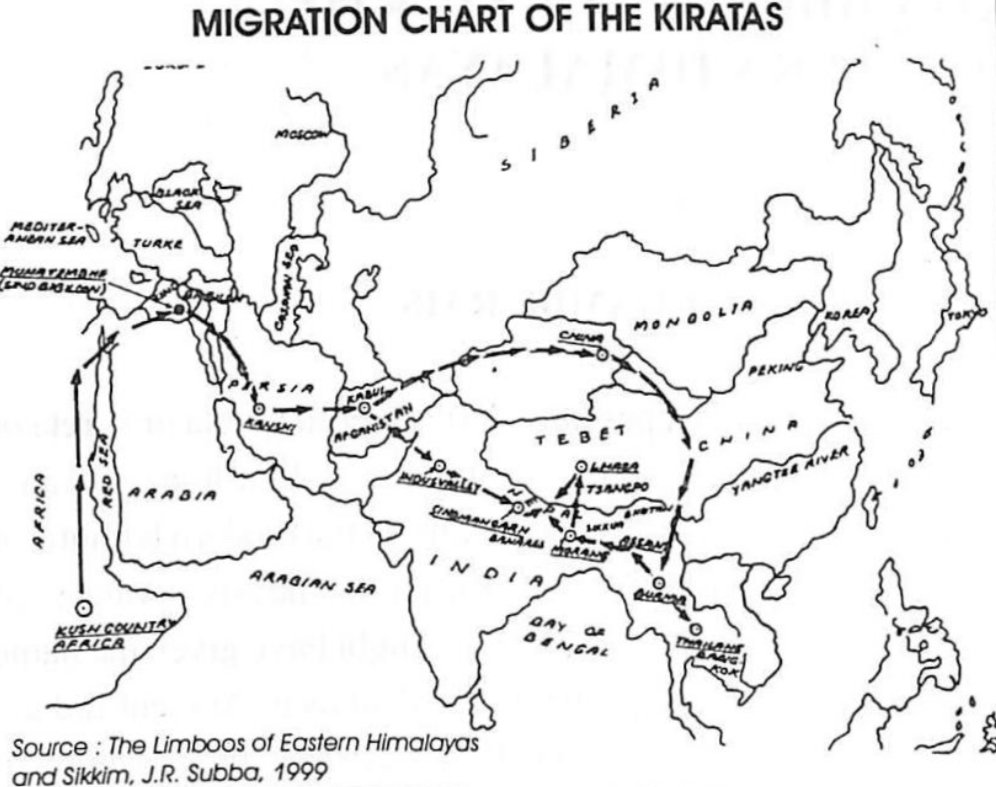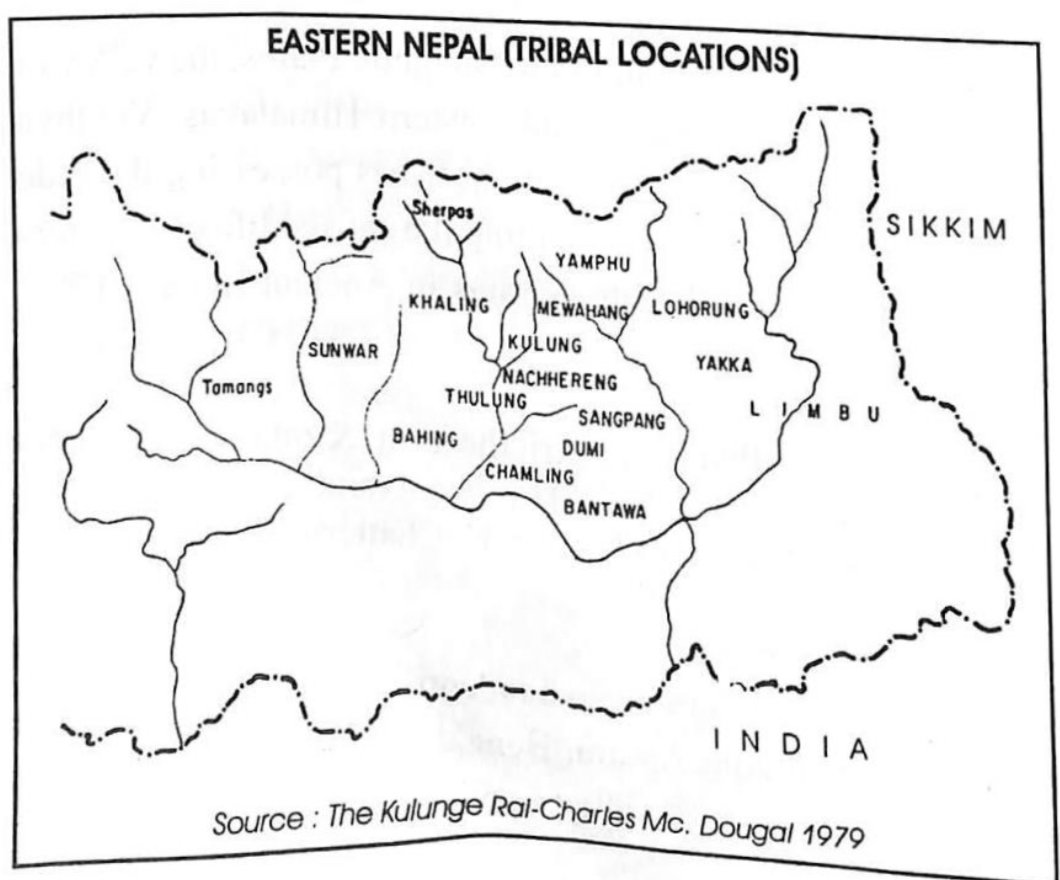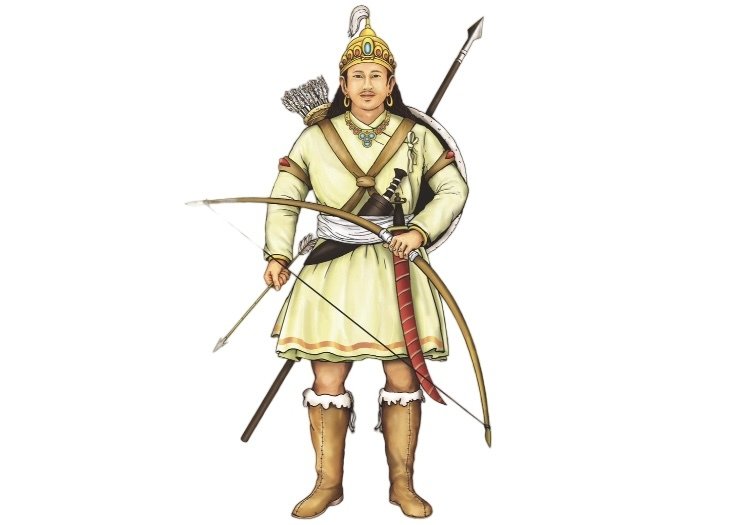HISTORY Of KIRAT KHAMBU RAI
According to G.P.Singh, the word KIRATA has been possibly derived from Cirata or Cireta or Cirayita, also known as 'Kirata - Tikta' or *Anarya - Tikta' - a bitter plant of the non - Aryans, grown in the lower regions of the Himalayas, which forms the country of the modern Kirantis or Kiratas. This is the name of a drug which was obtained from the Kiratas by the Aryans and used for medical purposes. It is also possible that the Kiratas themselves might have given the name to the drug, which was as bitter in taste as they were. (G.P.Singh:- Kiratas in Ancient India - 1990, pg. 96). The most popular Pali and Prakit form of an appellation *Kiratas used in Sanskrit and common parlance, is Cilata.
It is not correct to state that the term Kirata was loosely applied to any hill folk, no doubt aborigines or used only for the primitive cave dwellers of the Himalayas, foresters and uncivilized or barbarian mountain tribes. It is also not a correct explanation that in Sanskrit literature, the term seems to have been used indiscrimately to designate only the border tribe of the Northern and Eastern Frontiers. Nor is it quite proper to call the Kiratas as a mere Himalayan mountaineers and to identify them only with the Kirantis, who once reigned over a large portion of Eastern Nepal.
They were a distinct class of tribe having their settlement in the Gangetic Plains, the valley of Nepal, the hills and the mountains of Northern, Central and Eastern Himalayas, Vindhya region, etc. As a matter of fact, not only the non-Aryan mountain tribes possessing the rude culture, but also the degraded members of the Aryan stock leading the savage life of foresters were known as the Kiratas in ancient Times ( G.P.Singh- Kiratas in Ancient India - 1990, pg.95).
"It is the consensus of opinion among Indologists that in Sanskrit the term 'Kirata indicated the wild non-Aryan tribes living in the mountains particularly the Himalayas and the North Eastern areas of India who were Mongoloid in origin". (Kirat Jana Krit-S.K. Chatterji - Page 26-27)

Geographical Spread of the Kiratas/Kirats/Kirantis:-
Kiratas as a whole, as described in the classical literature can be identified with those tribes of North Western India, North Eastern India including Assam, Bengal. Tripura. Orrisa. Nepal, Sikkim. Tibet and Burma, who had settled in the plains. valleys, and hills between the epic age and the 5th Century A.D. (G.P.Singh:- Kiratas of Ancient India-1990,pg 113). The earliest recorded references including the appellation Kirata, occur in the Vedic literature, including the Samhitas and the Brahamanas, which were compiled roughly between 4500 - 1000 B.C. The hymns of the two later Vedic texts, the Sukla - Yajur Veda and the Atharva Veda throw light on their dwellings in the caves and mountains of the Eastern Himalayan region, there contacts with the Vedic Aryans, antiquity, etc. (G.P.Singh - Kiratas in Ancient India - 1990, pg. 19).
It is generally held that the name Kirata was applied to the numerous fair complexioned or yellow coloured hill tribes of Mongolian race that lived in all parts of the Himalayas. But, on the basis of the description of the physical features available in the epics (Ramayana and Mahabharata) and the Puranas, we find that they were both yellowish and darkish complexion. Their general and physical Characteristic show that they were a race of dwarfish stature with short arms, round face, projecting chin, broad head, flat nose, oblique eyes, etc,whose descendents are mountaineers and foresters.
The Ancient Kiratis have not at all disappeared from the history of India. One section of them is geographically, racially and linguistically represented by the modern Kirantis in the Easternmost province of Nepal.The kiranti or Kirats are no doubt those, who were dwelling on the slopes of the Himalayas, especially in the Kirata - desa, on the mountainous country lying between the Dud -Kosi and the Karki rivers in Nepal. They are generally identified by Khambu, Limbu and Yakha or Yakthumba tribes. They are believed to be the descendents of the ancient Kiratas of Nepal".The Kirata tribe even at present occupy the portion of the Eastern Territory of Nepal between the rivers Sunkosi and Arun. The Nepalease traditions and chronicles or 'Vamsavalis' also proved that they were an offshoot of the tribes now living in that part of the country called Kirata-Desa.".
The Kiratis living between the Sapta- Kausaki and Sapta - Gandaki (representing ancient Nepal) have been correctly identified by Hodgson with classical 'Cirrhadae' (Kiratas) with regard to the affinity of the tribes, thus conjoined, he observed that they are closely allied race having essential community of customs and manners and they all inter-marry. In the geretic term also, the Kiratas include the Limbus, the Ekas (Hodgson's Yakhas) and Rais and that in appearance and habit, they are all very much alike to each other. They are subdivided into various tribes. A vast majority of Rai-Limbu now found in Sikkim, Nepal and Darjeeling still call themselves as the Kiratis ) ( G.P.Singh - Kiratas in Ancient India - 1990, pg. 113to 116). Eastern Nepal and its neighbourhood have been appropriately named as Kirant country. The Kirantis or Kiratis inhabiting this country in the larger sense are sub - divided into three different parts- viz:- Wallo Kirat or Hither Kirat from Sunkosi to Likhu river, including the Limbus, Yakhas and Lohorungs. Majh or Middle Kirant from Likhu to Arun river comprising (Khambus), Bontawa, Rodong, Dungmali, Khaling, Dumi, Sampang, Bahing, Thulung, Kulung, etc. Pallo or Further Kirant from Arun to Mech river and the Singilela inhabited by (Limbus and Yakthumbas) Chourasya.

The old name of the Kirat country in Eastern Nepal was "Nao- lakh Kirat" The Khambus live to the Northern East of Jimdars and Yakhas, or the Southern spurs of the Himalayas. They are also associated with the fighting tribes of Nepal, who are placed under the head of Kirats. Hodgson has placed the complex pronominalised language of Nepal under the head of Kirantis, which is connected with Tibeto-Burman group.
The most powerful section of the Kirantis who settled down in the valley of Nepal in ancient times, probably in the pre-Christian era, are identified with the present day Kiratas - ie Kulung, Thulung and Yellung". (G.P.Singh- Kiratas in Ancinet India - pg.116, 117). The most powerful section of the Kirantis who settled down in the valley of Nepal in ancient times, probably in the pre-Christian era, are identified with the present day Kiratas - ie Kulung, Thulung and Yellung". (G.P.Singh- Kiratas in Ancinet India - pg.116, 117).

The first Chieftan (King) Yalambar of the Kiratas / Kirats
The Kiratas colonized the valley of eastern Nepal, North Videya, in sub Himalayan region after having conquered it and set up a dynastic rule in pre-Christian era in succession to the Abhiras, and ruled for about 29 generations from 400 B.C to 700 A.D. Their first Chieften (king) was Yalamber (Yalambara, Yellung or Yalambhang ) and their Kingdom extended from river Trisuli in the west to the river Tista in the east. Jitedasti (Jitadesi, Jitadastihang) was the seventh ruler of the dynasty. He was the most prominent among the early ruler of the dynasty. The king after being persuaded by Arjuna went to Kurushetra, took part in the war of Mahabharata on behalf of the Pandavas against the Kauravas. and lost his life.
According to Pt. Bhagwan Lal Indraji. He had ascended the throne five hundred thirty six years later than the Gopala Dynasty -(i.e first ruler of Nepal). The Kiratas were finally dethroned by Abhira Gupta by the end of the Seventh Century A.D., which was the end of the dynasty but not the total annihilation of the Kirata population.) (G.P.Singh - Kiratas in Ancient India - 1990, pg. 128,363,364,396). The tribes allied to Kiratas of eastern Himalayas and the Gangetic Delta ( the people of Khasi Jaintia hills, the Garo hills, Sikkim and eastern Bengal) bartered 'tez pat' (Malabathrum Cinnamomum albiflorum) with China for Chinese raw silk yarn, have been designated both as Basatae (Besadai) and Sesatai (Sesatae) in classical literature. The import of the Silk from China has also been supported by J. Wame Edgar, who extensively traveled in the frontier areas of Tibet and Sikkim. S.K Chatterjee is also of the opinion that the Kiratas of Assam imported raw silk yarn and silk cloth from Thinai or China [G.P. Singh Kiratas or Ancient India 1991, Page 210 to 213].
"The Kiranti people of East Nepal, more commonly known as Rai and Limbu, form together one of the largest single ethnic groups in Nepal, second only to the Tamangs. As numerous as they are, they are divided into a number of smaller 'thar' (clan) / Tribal units, the major two being Rai and Limbu. Rai is technically a term meaning headman' but has over the yeats become the popular generic term of reference for the entire ethnic group. The Rai in some districts are called "Jimdar' or 'Jimi', in other arcas "Khambu' and in some places they are referred to by a particular thar' clan designation. In the course of time 'Rai' came to include the Yakha people, a third sub-division of the Kiranti. Limbu people are addressed as Subba, a term which like Rai means 'Chief" or 'headman'. In general however, when speaking of the Kiranti people we refer to Rai and Limbu not Rai and Subba. Northey and Morris have written concerning the origin of these terms when Shah Gurkhas conquered the Kiranti Tribes, the Gurkha Kings established some of the Jimdars as local rulers and gave them the title of Rai and Limbu headman similarly called Subba. In time the use of these names came to include whole groups and now we find Jimdars called Rai, Limbus called Subba and the Yakha people Dewans". (People of Nepal - Dor Bahadur Bista, Kathmandu - 1971 Page 32).
Physically, linguistically and to some extent culturally, the Rais and Limbus are related to the larger Mongoloid tribal people spread eastward through the sub-Himalayan region and hills of Assam (now North-Eastern States). Their movement into Nepal hills must be understood in relation to the spread of Mongoloid Tibeto-Burman speaking people throughout the eastern Himalayan region as a whole, which was probably gradual and effected by a series of displacements. Rai tradition relates thet the first of the ancestral Kiranti entered Nepal's eastern hills through the Barakshetra gorge of Kosi valley, the natural gateway into the region through the Mahabharat Range which separates the hilly interland from the plains. According to Kulunge Rai version, there were three brothers Khambuho, Menho and Meratup. Once through the gorge the brothers separated, each taking his respective followers and set out independently as they penetrated up the different river valleys such as Sun Koshi, Dudh Koshi and Arun Koshi. The term 'Khambu' often is used to refer collectively to the Rais. The relation between the Rais and Limbus is conceived of as that between the descendants of two brothers. Certain writers (W. Brook, Northey and C.J.Morris, The Gurkha, London 1927) speak of a ripartite division of the Kirati into Khambus, Limbus and Yakhas but it is preferable to treat the atter simply as one of the tribes within the Rais; infact they refer to themselves as Yakha Rais." The Kulung Rai -Charles Mcdougal - Page 3).
According to Eden Vansittart (Gurkhas - 1906-pg 99), the Kiratis include :-
I. Limbus or Yakthumbas
II. Rais or Khambus and Yakkhas
By right it should apply to the Khambus (Rais) only. But as Khambus, Yakkhas and Yathumbas can and have intermarried for many generations, the three nations, although at one time quite separate have for all practical purposes, being fused into one and the same nationality, hence we find their manners, religious ceremonies, customs and appearances are almost the same. To the Khambus, Yakkas and Yakthumbas, therefore, might for all practical purposes be applied the term Kirantis.
Suniti Kumar Chaterjee in his celebrated work, Kirata - Jana-krti, makes an exhaustic survey of the ancient connotations of the word and those akin to it in the Indo - Aryan languages (1951:17-19). From what he has illustrated, the word 'Kirata' had a negative, subhuman or animal connotation. For instance, in the Vedic as well as other Indo - Aryan literature, this word referred to an ugly men, a wild man, a cruel and mean person, a corn chandler, a robber, a forester and the like. This is similar to Leo Kuper's remarks: dehumanization is the most common process in the characterization of subordinate races by a dominant race' There is little doubt, however that the Kiratas are of Mongloid origin. Chatterjee writes that Indologists agree that the Kiratas have a "non Aryan" or "*Mongoloid" origin (1951:6). This is endorsed by Chemjong too, though he mistakes 'nationalities' for 'races' (1966:4). While Chatterjee associates them with the northeastern Himalayas, he does not negate the view of Gopal Chandrea Praharaj who locates then in "Northern India" nor does he refute Janendra Mohan Das who claims that the ancient habitat was the "Eastern Himalayan tracts, including Sikkim and Bhutan, and Manipur and other adjacent tracts, which are exactly the lands of Mongoloid settlement in India" (Chatterjee 1951:18).
Milton Sangma, a noted historian, writes that the word "Kirata" refer to the "people now represented by the Mongoloid group inhabiting different parts of North East India" (1985:59). In the classic work Kirata Janakrit (1951) by Suniti Kumar Chatterjee, he mentions the Limbus, Khambus, and the Yakkhas living "on the Indian side of the Himalayas, in Nepal and Sikkim" as Kiratas.
I.S Chemjong (1966) on the other hand includes almost all Mongoloid groups of Nepal like the Lepcha, Mangar, Gurung, Tamang, Sunwar and Hayu under the umbrella of word Kirata.
D.R.Regmi, in ancient Nepal, provides yet another view. According to him, "not all the people in Eastern Himalayas but only two of them, the Khambus and Limbus, are taken as Kiratas" (1969:16). However, le adds that the identification of a "section of Newars" with "the historical Kiratas as their own descendents may not appear far - fetched (1969:55). For instance, Northes and Morris write that the Dunwars and Thamis also legitimately claim to be Kirata (1974:215). Northey and Morris write that the Kiratas occupied *the country right up to the eastern boundary of Nepal. Although the eastern frontier of Nepal is formed by the Singalela ridge, the country east of this, comprising theBritish district of Darjeeling, is peopled almost entirely by members of the Kiranti race, and large members of them are to be found still further east in the little hiss state of Sikkim" (1974:213). {T.B. Subba- Politics of Culture - A Study of the Three Kirata Communities in the Eastern Himalayas- 1994: page 22-35).
As to the question about the origins of the Kirat Khambu Rais, they are the aborigina tribes of this region. They are a Mongolian race and descendents of the Kiratas which have bee described in the old Sanskrit texts particularly in the epics of Mahabharata and Ramayan? (Martin Gaenszle- 1991-4). They are described as a warring race inhabiting the north and nor eastern Himalayas. They are described as uncout barbatians on the boarder of civilized India. living as gatherers of fruits, tubers and by hunting and fishing. They had* golden skin colour There is an episode in the Mahabharata in which lord Shiva, disguised as a Kirata, turns agains Arjun, but in the end, presents him with the miraculous "Pasupata" weapon.
With the establishment of tea gardens by the Britishers in the hills of Darjeeling in middle of 19th Century, a large number of Kirat Khambu Rais started working in the tea gardens but others still remained as farmers. It is to be recorded that Kirat Khambu Rai also served the British army as soldiers, but after Independence a majority of them joined the Indian army. A major recruiting depot was in Darjeeling. After retirement many of these personals settled in various parts of India but especially in Sikkim, Darjeeling district of West Bengal and North Eastern States.